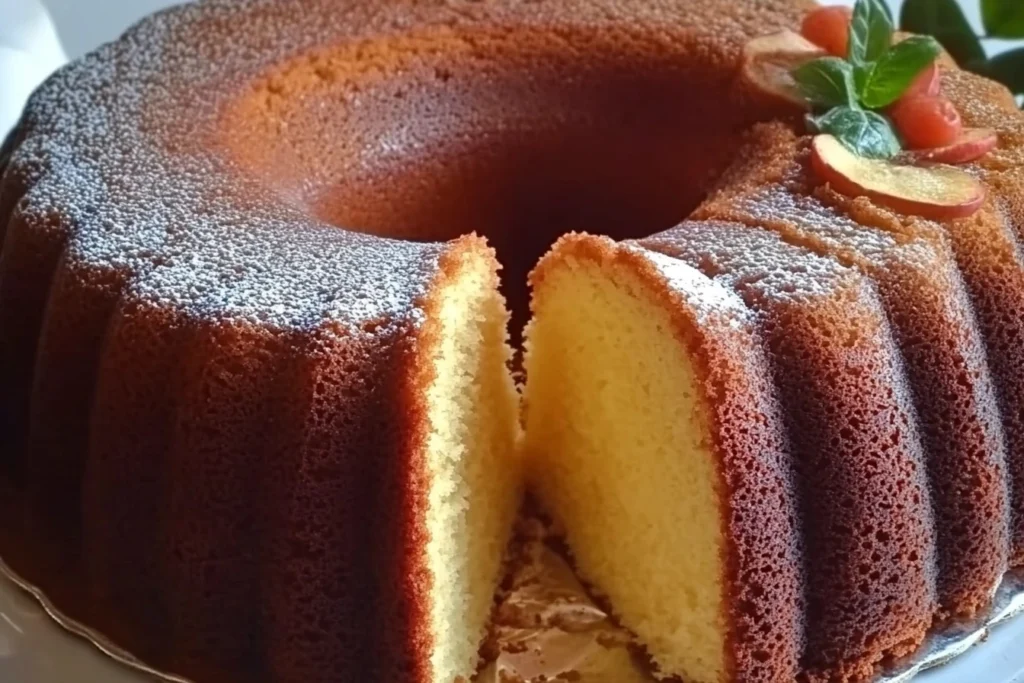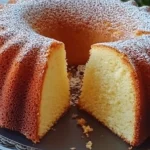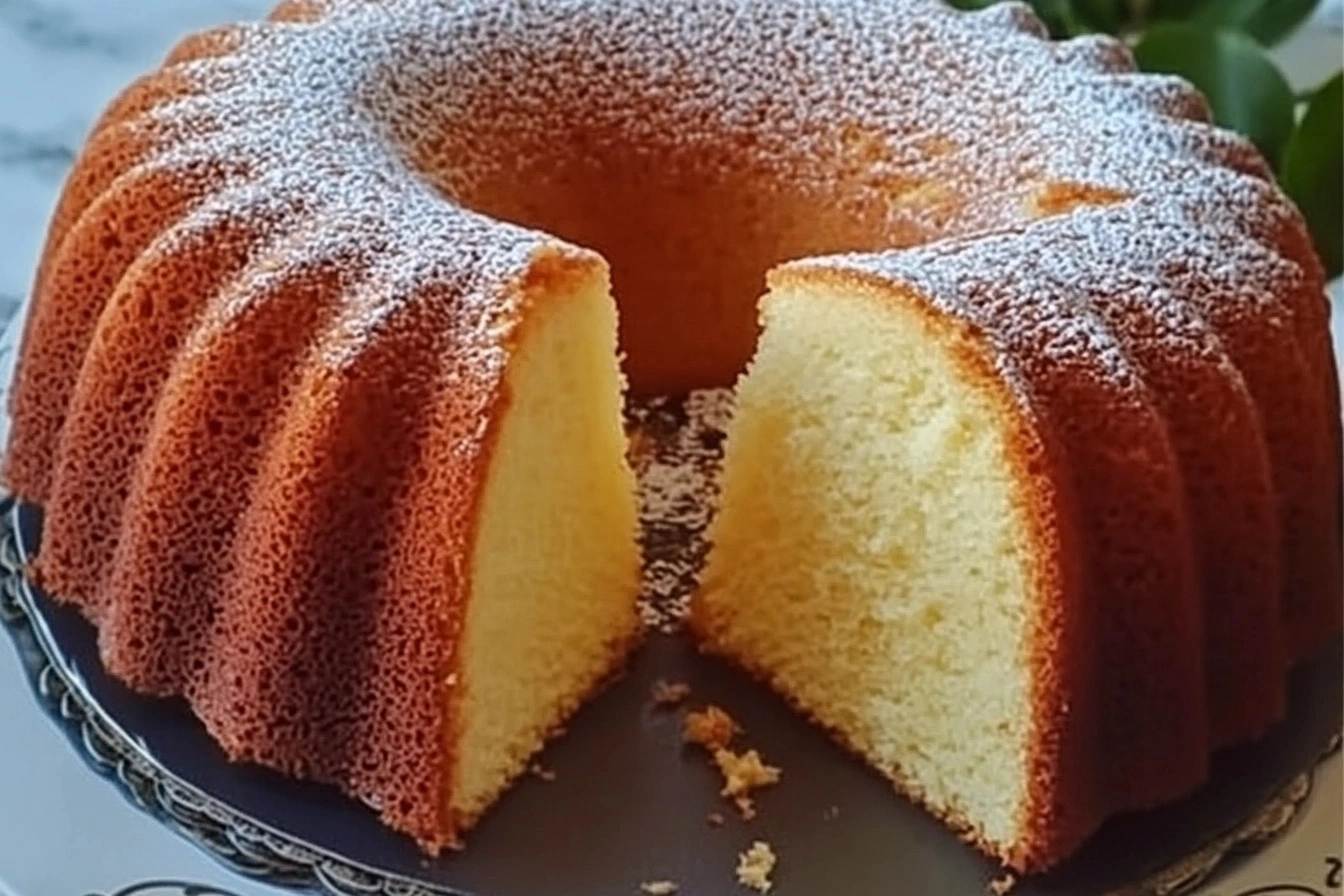Table of Contents
Introduction
There are some recipes that stick with you, not because they blow your mind with crazy flavors or exotic ingredients, but because they hit you right in the gut with nostalgia. The classic vanilla pound cake is one of those. It doesn’t scream for attention. It doesn’t need a fancy garnish. It just is—buttery, dense, and unapologetically old-school. This is the kind of cake you eat in thick slices with black coffee at 6 a.m., or sneak into the kitchen for at midnight, barefoot and half-awake.
It dates back to the 18th century, originally calling for a pound each of flour, sugar, butter, and eggs. Over the years, the formula evolved, but the soul of the cake stayed the same. Rich, moist, and infused with the warm aroma of vanilla, this cake feels like home. Whether you’re baking it for a Sunday brunch, a potluck, or just because it’s been one of those weeks, it delivers. Every. Single. Time.
You won’t find any frills here. No need for a frosting that takes 45 minutes to whip up. Just simple ingredients, a little care, and a whole lot of flavor. This is the kind of recipe that earns a permanent spot in your kitchen arsenal. It’s not trying to impress. It just does.
Why You’ll Love This Recipe
- Timeless flavor: Pure vanilla with a buttery crumb.
- Simple ingredients: Nothing exotic, just pantry staples.
- Reliable: Comes out great every single time.
- Versatile: Serve it plain, with berries, or a drizzle of glaze.
- Perfect texture: Dense, moist, and rich without being heavy.
- Great make-ahead option: Tastes even better the next day.
Ingredients
- 1 cup (2 sticks) unsalted butter, softened
- 1 1/2 cups granulated sugar
- 4 large eggs, room temperature
- 2 teaspoons pure vanilla extract
- 2 cups all-purpose flour
- 1/2 teaspoon baking powder
- 1/2 teaspoon salt
- 1/2 cup whole milk, room temperature
Instructions/Method
- Preheat oven to 325°F (163°C). Grease and flour a 9×5-inch loaf pan or line it with parchment paper.
- Cream the butter and sugar together in a large bowl using an electric mixer until light and fluffy, about 3-5 minutes.
- Add eggs one at a time, beating well after each addition. Mix in the vanilla extract.
- In a separate bowl, whisk together the flour, baking powder, and salt.
- Add dry ingredients to the wet mixture in three parts, alternating with the milk. Start and end with the flour mixture. Do not overmix.
- Pour batter into the prepared loaf pan, smoothing the top with a spatula.
- Bake for 60 to 70 minutes, or until a toothpick inserted into the center comes out clean.
- Cool in the pan for 10 minutes, then transfer to a wire rack to cool completely.

Tips & Variations
- Use room temperature ingredients: This helps everything blend smoothly.
- Don’t overmix: You want a tender crumb, not a chewy one.
- Add-ins: Try lemon zest, almond extract, or a swirl of berry jam.
- Glaze it: Mix powdered sugar and milk for a quick glaze.
Note
Avoid opening the oven door during baking; it can cause the cake to sink.
Serving Suggestions
- With coffee or tea: Perfect afternoon or breakfast treat.
- Topped with whipped cream and berries: For a light dessert.
- Toasted slices: A pat of butter takes it to another level.
- As a base for trifles: Holds up well with layers of cream and fruit.
Nutrition Information
- Calories: 320 per slice
- Fat: 18g
- Saturated Fat: 11g
- Cholesterol: 95mg
- Sodium: 180mg
- Carbohydrates: 36g
- Sugar: 22g
- Protein: 5g
User Reviews/Comments
Mary J.: “I baked this for my book club and it disappeared in minutes. So simple, so good.”
Tariq R.: “Reminds me of my grandma’s pound cake back home. Nostalgic and delicious.”
Anna K.: “I added lemon zest and a glaze—came out fantastic. This one’s a keeper.”
FAQs
Can I use cake flour instead of all-purpose flour?
Yes, but it will result in a slightly softer texture. Stick with all-purpose for that classic density.
Can I freeze vanilla pound cake?
Absolutely. Wrap it tightly in plastic and foil, and it will keep in the freezer for up to 3 months. Thaw at room temperature before serving.
Why did my pound cake crack on top?
That’s normal and expected. The batter is dense, so the top often splits as the cake rises. It’s part of the charm.
Can I use margarine instead of butter?
Technically yes, but you’ll lose that deep, rich flavor. Butter is best here.
What if I don’t have a loaf pan?
You can use a bundt or tube pan, but adjust the baking time and keep an eye on it.
Conclusion
The classic vanilla pound cake is a testament to the power of simplicity. No flashy techniques or ingredients, just a humble loaf of rich, buttery perfection that always hits the spot. It’s the kind of dessert that doesn’t need to explain itself. You taste it, you know. Keep it plain, dress it up, toast it the next morning—whatever you do, this cake delivers comfort by the slice. It’s a little piece of culinary history baked into your kitchen, and it deserves a regular spot on your table.
If you’re interested in the origins of pound cakes and how they evolved through culinary traditions, check out the Wikipedia article on pound cake.
Print
Classic Vanilla Pound Cake
Ingredients
- 1 cup (2 sticks) unsalted butter, softened
- 1 1/2 cups granulated sugar
- 4 large eggs, room temperature
- 2 teaspoons pure vanilla extract
- 2 cups all-purpose flour
- 1/2 teaspoon baking powder
- 1/2 teaspoon salt
- 1/2 cup whole milk, room temperature
Instructions
- Preheat oven to 325°F (163°C). Grease and flour a 9×5-inch loaf pan or line it with parchment paper.
- Cream the butter and sugar together in a large bowl using an electric mixer until light and fluffy, about 3-5 minutes.
- Add eggs one at a time, beating well after each addition. Mix in the vanilla extract.
- In a separate bowl, whisk together the flour, baking powder, and salt.
- Add dry ingredients to the wet mixture in three parts, alternating with the milk. Start and end with the flour mixture. Do not overmix.
- Pour batter into the prepared loaf pan, smoothing the top with a spatula.
- Bake for 60 to 70 minutes, or until a toothpick inserted into the center comes out clean.
- Cool in the pan for 10 minutes, then transfer to a wire rack to cool completely.
Notes
Avoid opening the oven door during baking; it can cause the cake to sink.
